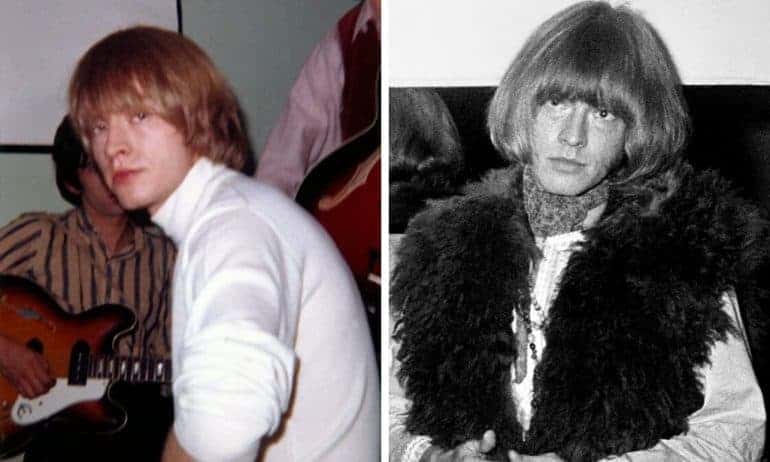A lot of people don’t always recognize the name Brian Jones, or quite comprehend his importance in the music world. Therefore, Rocks Off is diving deep into his life to understand exactly who was Brian Jones.
It’s quite astonishing how much Brian Jones achieved in his short lifetime. On top of forming and naming the Rolling Stones, hence where the phrase ‘No Jones No Stones’ comes from, Jones co-wrote and contributed to some of the Stone’s most diverse and memorable tracks.
Despite being a very talented multi-instrumentalist with a keen desire for experimentation, Jones never wrote any of his own songs which remains a mystery as to why.
Embed from Getty ImagesWho Was Brian Jones?
Born on February 28, 1942, as Lewis Brian Hopkin Jones Junior in Cheltenham Park Nursing Home, he lived a typical middle-class life in southwestern England. He had two little sisters, the eldest of whom died of leukemia when he was only three years old.
His parents were both musically inclined which sparked his initial interest. Brian Jones’ father was an aeronautical engineer by day but would also teach and play the piano. His mum also played the piano and frequently played the organ at their local church.
As a result of his parents’ passion for music, Jones grew up listening to a lot of classical music, jazz, and blues, especially the likes of Elmore James and Robert Johnson. He persuaded his parents to buy him a saxophone to express his love of jazz and blues, and 2 years after that, an acoustic guitar. He excelled in school despite his growing lack of effort and resistance to conformity. However, at the age of 17, he got his girlfriend pregnant and decided to drop out.
Embed from Getty ImagesAt some point between 1961 and 1962, Brian Jones moved to London where he became engrossed in the blues music scene. He quickly became friends with fellow blues enthusiasts such as Alexis Korner, often referred to as the “Father of British Blues,” future singer of Manfred Mann Paul Jones and even future Cream bassist Jack Bruce.
For a brief while, he called himself Elmo Lewis and became known for playing slide guitar. He ended up starting a band with Paul Jones, naming themselves the Roosters. In 1963 he left the band and Eric Clapton took his place as guitarist.
No Jones No Stones
In early May of 1962, Jones placed an ad in Jazz News (a Soho club info sheet) seeking musicians to audition for a new R&B band at the Bricklayers Arms pub. Ian “Stu” Stewart was the first to join the group, with Mick Jagger swiftly following suit.
A childhood friend of Jagger’s, Keith Richards, had met Brian Jones at the Ealing Jazz Club before. Mick brought him to one of the rehearsals one day where he joined the band soon after.
They began to practice regularly in a room above the Bricklayers Arms pub in Soho. The newly formed band had their first major break when friend Alexis Korner’s Blues Incorporated was invited to perform on BBC Radio’s Jazz program. This meant that their usual gig slot at the Marquee Club was free for the taking.
Brian Jones then persuaded the club’s owner Harold Pendleton to let them fill the spot. As Keith Richards recalls, Jones came up with the name the “Rollin’ Stones” (later with the ‘g’) while on the phone with Harold Pendleton.
Embed from Getty ImagesDespite the rest of the band not being too fond of the name the Rollin’ Stones, they couldn’t come up with anything better.
On Thursday, July 12, 1962, they played their first gig at the Marquee Club in London. The line-up consisted of Jagger, Richards, Jones, Stewart, Dick Taylor on bass, and drummer Tony Chapman. The gig led to a residency arrangement at the Marquee Club.
Although things were looking up for the band, they were still strapped for cash so Jones, Jagger, and Richards decided to move into a flat together in August of 1962. Keith often referred to their place as a “beautiful dump.”
Despite the grimness of the place, it was fundamental to their rise in music success. Jones and Richards would spend all day playing guitar and listening to blues records from the likes of Jimmy Reed, Muddy Waters, Howlin’ Wolf, and Willie Dixon.
This bonding contributing to their weaving guitar styles which set them apart from other London blues bands at the time. Jones also taught Mick how to play the harmonica.
Early Signs of Estrangement
During the early days, Brian viewed himself as the band’s manager and often demanded an extra five pounds more than the other members of the band for playing the same show.
Although he did bring the band together initially and was extremely influential in their early blues sound when the rest of the band discovered his extra pay they were not best pleased.
This led to the formation of the first cracks between Brian and the rest of the band. In May of 1963, Andrew Loog Oldham arrived as the manager of the Stones. According to Oldham, Brian Jones had already started to become estranged from the rest of the band.
During their first tours in 1963, Jones would often travel separately from the band and even stay at different hotels. I think the main issue for Jones was that Oldham wanted to change the band’s musical direction and move away from their bluesy covers. As well as focus their live performances on Mick Jagger’s charismatic flamboyance.
“Tortured soul, out of balance, cracked, vulnerable, manipulative, devilish,” were just some of the terms used to describe Brian Jones during this time by his contemporaries with Bob Dylan famously greeting him by saying, “Hi Brian, how’s your paranoia?”
Beatlemania
Oldham also saw the Stones as a potential antithesis to the Beatles. Thinking that not every young person could identify with the squeaky-clean appeal of the Beatles, he transformed the Stones into a grittier and looser band.
He also encouraged Jagger and Richards to write more originals and from a partnership comparable to that of John Lennon and Paul McCartney. Apparently on some occasions even going as far as locking them in a room together until they produced original work.
Although it’s easy to point the finger at Jones’ estrangement to him not liking the new direction of the band, it was Jones who really embraced the psychedelic movement and embraced non-blues instruments such as the flute and mellotron. I think it was more a result of his decreased managerial control of the band as well as his dwindling importance and influence on the band musically.
Embed from Getty ImagesAt the same time, Jones’ began to overindulge in drugs and alcohol. Most likely as a coping mechanism for the increased time on the road, money, and fame, and the general feeling of being alienated from the group. Excessive use began to have a crippling effect on his physical and mental well-being.
Other members of the Stones remember times when he could be the friendliest person in the room and times when he would be completely anti-social. Years later, Richards would say that Jones wasn’t the type who could handle the fame and fortune.
Brian Jones Girlfriend – Anita Pallenberg
In March 1967, Brian Jones met Anita Pallenberg, a 21-year-old model who he believed to be the love of his life. They both spoke German and instantly hit it off, quickly becoming passionate lovers. Anita helped Jones develop his rock star persona and style. She even cut his hair into his signature look and was influential in getting him to wear flamboyant clothing.
Sadly, their relationship began to turn sour, largely as a result of their excessive drug addiction and alcohol use. Jones and Pallenberg began to experiment heavily with LSD, which took a toll on his mental state giving him bad nightmares.
He also turned physically abusive towards Anita. Spurred by mood swings and fits of jealousy, things came to a head when Richards, Pallenberg, and Jones took a trip to Morocco.
Embed from Getty ImagesJones became ill and was hospitalized, leaving Richards and Pallenberg alone together. They quickly fell for each other and Anita soon left Jones for Richards. This not only broke his heart but further strained his relationship with Richards.
As tensions rose and Jones’ substance abuse reached an all-time high, he began to suffer musically and instead gravitated towards playing more exotic instruments. He became very unreliable and difficult to work with, often not showing up to recording sessions and even sometimes with the wrong equipment.
Apparently, it got so bad during Their Satanic Majesties Request and Beggars Banquet sessions that the band would regularly just turn off his amplifier.
Brian Jones Last Photo
In May of 1968, Jones was arrested for a second time, as a result of the possession of marijuana. Luckily the judge let him off the hook with just a £50 fine. The following year his legal troubles continued when he had the group’s Jaguar towed while shopping on Pimlico Road, London and also crashed his motorcycle into a shop window.
At this point, Jones was making very little contribution to the Rolling Stones musically. By the time the sessions for Let It Bleed were wrapping up, he had all but checked out only playing on two tracks, “Midnight Rambler” and “You Got the Silver.” Additionally, Mick Jagger told Brian that if he missed the upcoming photo sessions he would be fired from the band.
Rather surprisingly, he turned up. His last photo session as a Rolling Stone took place on 21 May 1969, first at St. Katherine Docks, Tower Bridge, London and then at Ethan Russell‘s studio in South Kensington. The photos appeared on the album Through The Past Darkly (Big Hits Vol.2) in September 1969.
Who Replaced Brian Jones?
By June of 1969, the Stones were gearing up for their first US tour in three years on the back of the release of the Let It Bleed album. However, the band’s management was informed that because of Jones’ previous drug convictions, he would not receive a work permit and therefore could not attend the tour.
Embed from Getty ImagesAt the proposal of Ian “Stu” Stewart, their road manager and touring pianist, they decided to let Brian go and add a new guitarist. On June 8th, 1969, Jones was paid a visit by Jagger, Richards, and Watts where he was informed that he would no longer be a part of the band.
Although to the public it was made to look as if Jones left on his own terms. Jones released a statement the next day saying among other things that “I no longer see eye-to-eye with the others over the discs we are cutting. I want to play my kind of music, which is no longer the Stones music. The music Mick Jagger and Keith Richards have been writing have progressed at a tangent, as far as my own taste is concerned.”
Jones was replaced by 20-year-old guitarist Mick Taylor, formerly of John Mayall’s Bluesbreakers. I’m sure it must’ve been a tough decision for the band as well as for Jones to have to comprehend the band that he had formed was continuing without him.
After leaving the Stones, he retreated to his home in East Sussex. According to long time friend Alexis Korner, Jones appeared “happier than he had ever been.” He also went as far as contacting friends including John Lennon, Mitch Mitchell, Korner, and Jimmy Miller about starting a new band. Even demoing a few songs of his own including “Has Anybody Seen My Baby?” and “Chow Time.”
Brian Jones Death: When Did He Die?
Sometime after midnight on July 3rd, 1969, Brian Jones died. He was discovered at the bottom of his swimming pool by his Swedish girlfriend Anna Wohlin. The coroner’s report concluded that Brian Jones’ cause of death was misadventure, as it was noted his heart and liver were enlarged by drug and alcohol abuse. His death was felt by many of his contemporaries.
Embed from Getty ImagesPete Townshend of the Who wrote a poem called “A Normal Day for Brian, A Man Who Died Every Day,” which was printed in The Times newspaper. The Doors’ lead singer Jim Morrison also wrote a poem titled “Ode to L.A. While Thinking of Brian Jones, Deceased.” And Jimi Hendrix even dedicated a song to Jones whilst on U.S. television.
Two days after his death, the Rolling Stones performed a free concert in Hyde Park, which was dedicated to Brian Jones. Even though originally the concert was intended to introduce their new guitarist Mick Taylor.
Sadly, only Charlie Watts and Bill Wyman from the Stones were present at Brian’s funeral.
Was Brian Jones Murdered?
Soon after his death, theories that Brian Jones was murdered began to appear. Close friends of the Stones claimed to have insider information detailing that he was murdered.
In 1993, Frank Thorogood claimed that Rolling Stones’ driver Tom Keylock had murdered Brian. Thorogood was the last person to see Jones alive while working construction on the premises.
In 2008, Investigative journalist Scott Jones claimed to have new evidence suggesting that Thorogood had killed Brian Jones in a fight. In which Sussex police covered up the truth.
The case was then reviewed, where the police force later stated that “this has been thoroughly reviewed by Sussex Police Crime Policy and Review Branch but there is no new evidence to suggest that the coroner’s original verdict of ‘death by misadventure’ was incorrect.”
Brian Jones Songs
Sadly, the only officially released song that Brian Jones is credited for writing is “(Thank You) For Being There.” Even that was based on his poem but put to music by Carla Olson. Here’s what Keith Richards had to say on the matter:
It’s unfortunate that we’ll never get to know who Brian Jones really was or his true musical and song-writing ability.
Similar Stories…
- Conor Clapton – The Tragic Story Behind “Tears in Heaven”
- Marsha Hunt – The Complete Story of Mick Jagger’s “Brown Sugar”
- Monika Dannemann – The Last Girlfriend of Jimi Hendrix
- The Alice Cooper Fact Sheet – 5 Things You Need To Know - January 12, 2023
- Everybody Knows The Words, But What Is Hotel California About? - April 29, 2022
- What Is The Meaning Of Stairway To Heaven: Led Zeppelin’s Amazing 1971 Musical Epic? - April 24, 2022


